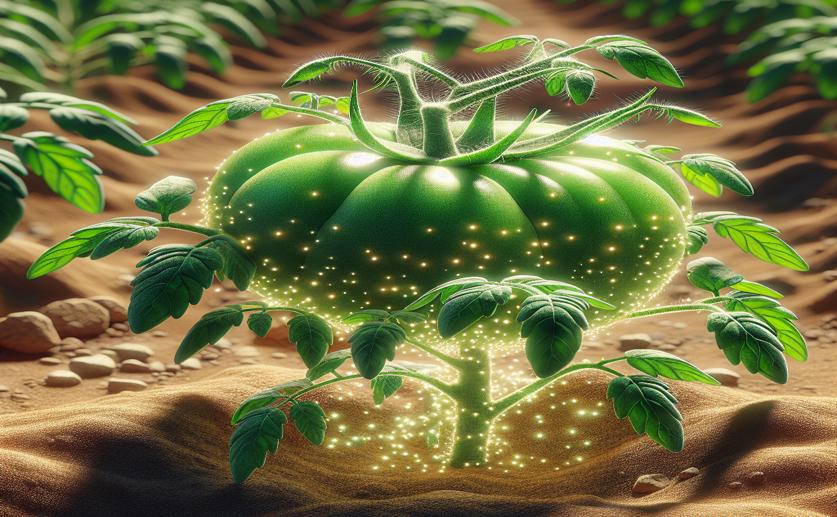Tiny Selenium Particles Boost Tomato Plant Drought Defense by Gene Adjustment

Image Source: Natural Science News, 2024
The success of tomato farming is intrinsically tied to the availability of water. In Iran, as in many parts of the world, drought poses a significant threat to agriculture, making every drop count when it comes to cultivating this important crop. Fortunately, science continues to explore innovative solutions to help plants withstand the stress of thirst. And a recent study showcases another stride in this direction—a beacon of hope employing two forms of selenium: selenate and its nano cousin, selenium nanoparticles or SeNPs, to be precise.
Let's venture into the intricacies of this research. Scientists discovered an intriguing strategy: the act of spraying tomato plants with SeNPs, specifically at a solution concentration of 4 milligrams per liter. This action was not just a one-time affair; after the third application, these nurtured plants were introduced to conditions simulating a water shortage. Remarkably, the selenium didn’t just sit there; it lent the plants a helping hand—or rather, a helping leaf.
The foliar intervention with SeNPs did a wonderful balancing act. It fostered growth, nudged the plants into blooming with aplomb, and, most strikingly, offset the risks of limited water with notable deftness. The research peered into the genetic orchestra within the plants, paying close attention to the tunes played by certain genetic elements, such as microRNA-172 (miR-172), traditionally known for their regulatory roles. Under standard watering, miR-172 hummed slightly louder in SeNP-spritzed plants, while it toned down its expression in face of drought stress.
Drought, of course, is a stressor that often tips the balance towards damage within the plant. In this case, it prompted an uptick in hydrogen peroxide accumulation—a marker of oxidative stress. But SeNPs rose to the challenge, safeguarding the plants and maintaining the integrity of their cellular membranes, akin to ensuring the walls of a fortress are unbreached.
The resilience imparted by SeNPs wasn't a simple one-trick feat. Imagine the antioxidants in plants as a lineup of superheroes, each with their own unique power: some non-enzymatic such as ascorbate (vitamin C) and glutathione, and others enzymatic like catalase and peroxidase. The introduction of SeNPs amplified the inherent powers of these plant protectors. And the synergy of all these antioxidants forms a formidable defense against the cellular damages wrought by water scarcity.
The protective prowess of these nanoparticles was further manifested in the way they propped up the plant’s metabolic might. Phenylalanine ammonia-lyase, proline, non-protein thiols, and the concentration of flavonoids—all critical molecules in a plant's response to stress—saw their activities and levels enhanced under the vigilant guard of SeNPs.
What's more, the benefits spilled over into the resultant fruits. Tomatoes from selenium-sprayed plants boasted higher concentrations of vital elements—potassium, magnesium, iron, and of course, selenium. These are not just abstract numbers; these minerals are key characters in the story of nutritious, quality produce. Each bite would contribute to a healthier, more nutrient-rich diet.
In closing this chapter of their quest, researchers noted that SeNPs functioned as a microscopic umbrella shielding tomato plants from drought's scorching impact. It's a story of how something seemingly insignificant in size, like nanoparticles of selenium, can loom large when it comes to securing our food sources against the adversities of climate.
This discovery could be a turning point, not just for Iran, but for arid regions worldwide where water scarcity grips the land and farmer's livelihoods. With such advancements, the agricultural sector can breathe a sigh of relief, knowing that science marches on by their side, uncovering solutions one nanoparticle at a time. And in those tiny particles, lies a world of potential for resilience, growth, and nourishment—a microscopic victory over the vast challenge of drought.
AgricultureBiotechPlant Science
References
Main Study
1) Selenium nanoparticles conferred drought tolerance in tomato plants by altering the transcription pattern of microRNA-172 (miR-172), bZIP, and CRTISO genes, upregulating the antioxidant system, and stimulating secondary metabolism.
Published 31st January, 2024
https://doi.org/10.1007/s00709-024-01929-y
Related Articles





 21st January, 2024 | David Palenski
21st January, 2024 | David Palenski